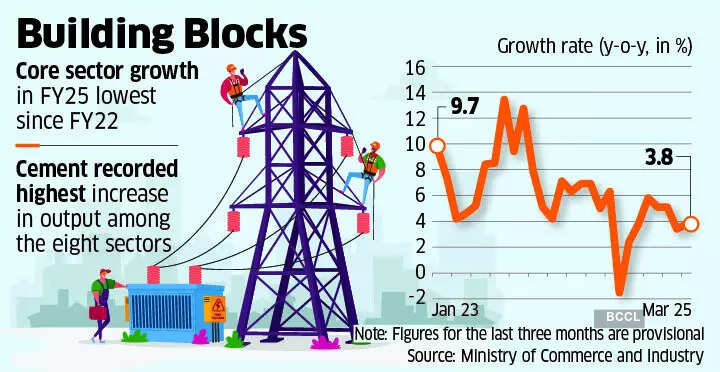NEW DELHI: India’s core sector growth rose by 3.8 per cent year-on-year (Y-o-Y) in March from an upwardly revised figure of 3.4 per cent in February, according to data released by the Ministry of Commerce and Industry on Monday. The growth was kept in check by a high base effect. In March 2024, core sector growth had stood at 6.3 per cent.
The growth in March was led by the electricity sector (6.2 per cent), followed by steel (7.1 per cent), and cement (11.6 per cent).
The core sector represents an index of eight main industries that measures the combined and individual performance of coal, crude oil, natural gas, refinery products, fertilisers, steel, cement, and electricity. These industries comprise 40.27 per cent of the weight of items included in the Index of Industrial Production (IIP).
In March, output decelerated in coal (1.6 per cent), refinery products (0.2 per cent) and fertilisers (8.8 per cent).
Meanwhile, the output in crude oil (-1.9 per cent) remained in contraction for the third successive month. Output in natural gas (-12.7 per cent) remained in contraction for the ninth successive month.
Overall, for 2024-25 (FY25), growth in the output of core industries stood at 4.4 per cent — its lowest level in the past five years. In FY21, the core sector had recorded a growth of -7.8 per cent.
In FY22, FY23 and FY24, it stood at 10.4 per cent, 7.8 per cent and 7.6 per cent, respectively.
Aditi Nayar, chief economist, ICRA Ratings, said that the Y-o-Y rise in the core sector was led primarily by the higher growth in electricity generation amid rising temperatures.
“In disaggregated terms, the sequential trend was quite mixed, with fertilisers, coal, natural gas, and refinery products reporting a moderation in their Y-o-Y growth in March relative to the previous month,” she added.
Madan Sabnavis, chief economist, Bank of Baroda said that the oil complex was subdued due to lower production of crude and natural gas due to low international price of crude.
“In the case of natural gas, higher imports substituted domestic production. Refinery products growth was flat at 0.2 per cent with lower prices and demand from exports affecting overall offtake,” he added.
Data released earlier this month had shown that growth in industrial production slowed to a six-month low of 2.9 per cent in February from 5.2 per cent in January as a high base and lacklustre demand pulled it down.
“Based on the expansion in the core sector, ICRA expects IIP growth to print at 3-3.5 per cent in March 2025,” said Nayar.
Starting April, core sector data is now being released on the 20th of every month as IIP data is scheduled to be released on 28th of every month, thus bringing down the time lag in the data of the macro indicators.
Source: Business Standard


 India Slaps 12% Safeguard Duty On Steel Imports From China, Others
India Slaps 12% Safeguard Duty On Steel Imports From China, Others 